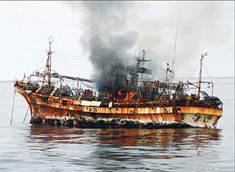
The long, lonely voyage of the Japanese ghost ship is over.
A US Coast Guard cutter poured cannon fire(开炮) into an abandoned Japanese ghost ship that had been floating since last year’s tsunami, sinking the ship into waters more than 305 meters deep in the Gulf of Alaska and removing the danger it created to shipping and the coastline on Thursday.
The cutter’s guns tore holes in the 164-foot Ryou-Un Maru, and then it began to take on water and lean to one side. In about four hours, the ship disappeared into the sea, said Chief Petty Officer Kip Wadlow.
The ship had no lights or communications system, and its tank was able to carry more than 7,570 liters of diesel fuel. Officials, however, didn’t know exactly how much fuel was aboard.
“It’s less risky than it would be running into shore or running into other ships,” coast guard spokesman Paul Webb said.
The US National Oceanic and Atmospheric Administration and the Environmental Protection Agency studied the problem and decided it was safer to sink the ship than let the fuel evaporate and pollute the sea environment.
Ryou-Un Maru was probably among the first wave of the 1.5 million tons of garbage of refrigerators, washing machines, televisions, roofs and fishing nets heading toward North America since last March when a magnitude 9.0 earthquake struck Japan.
As the coast guard was ready to fire on the ship, a Canadian fishing ship, the 19-meter Bernice C, claimed the rights to save the ghost ship in international waters.
Plans to sink it were paused so the Canadian crew could have a chance to take the stricken ship. A Canadian official with knowledge of the situation told the Associated Press that the Bernice C was unable to drag it.
Then the Canadian boat left, and once it was about 10 kilometers from the Japanese ship, the Coast Guard began to fire, first with 25 mm shells, then a few hours later with ammunition twice that size.
State officials have been working to test the danger of garbage including materials affected by a damaged nuclear power plant, to see if Alaska residents, seafood or wild animals could be affected.
小题1:Which of the following is NOT the reason for sinking the Japanese ship?
A.It had no lights or communications system.
B.It might be washed up onto the shore.
C.It was a danger to other passing ships.
D.The oil it carried could pollute the sea.小题2:The plan to fire on the Japanese ghost ship was paused because ________.
A.the ghost ship was beyond the reach of the Coast Guard’s guns
B.the shells were not powerful enough to sink the ghost ship
C.state officials worried the ghost ship might give out radiation
D.a Canadian fishing boat wanted to save the ghost ship小题3: Which of the following could be the best title for the passage?
A.Japanese ghost ship arriving at US
B.Tsunami garbage heading to US
C.Cannon fire sinking Japanese ghost ship
D.Japanese ghost ship polluting the Pacific
小题1:A
小题2:D
小题3:C
题目分析:本文叙述了一艘废弃日本的ghost船被炮火击沉,文中提到了击沉的几个原因,一是它可能会被冲到海岸带来危险。二是它对来往的船带来危险。三是它的燃料会给海洋带来严重的污染。
小题1:细节理解题。根据It’s less risky than it would be running into shore or running into other ships和it was safer to sink the ship than let the fuel evaporate and pollute the sea environment.故选A。
小题2:细节理解题。根据As the coast guard was ready to fire on the ship, a Canadian fishing ship, the 19-meter Bernice C, claimed the rights to save the ghost ship in international waters.一艘加拿大渔船想要救它,故选D。
小题3:标题归纳题。根据The long, lonely voyage of the Japanese ghost ship is over.
A US Coast Guard cutter poured cannon fire(开炮) into an abandoned Japanese ghost ship 故选C。
点评:标题是文章中心思想的精炼表达,多为词组或短语,涵盖性强。做这类题目时,要在阅读全文的基础上,以文章话题为核心,通过比较选项的概括性或 覆盖面,得出正确的标题。正确标题的归纳范围要恰如其分,避免过于具体或断章取义。错误的干扰往往是局部信息,以事实细节替代概括大意。
